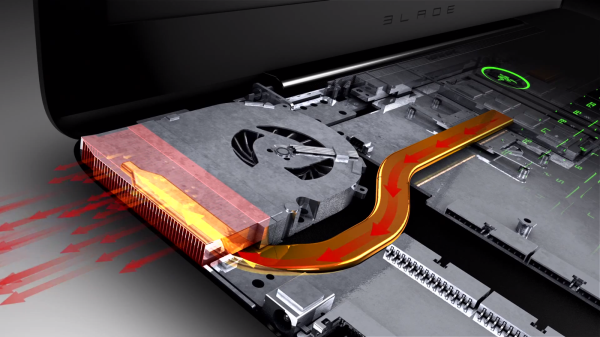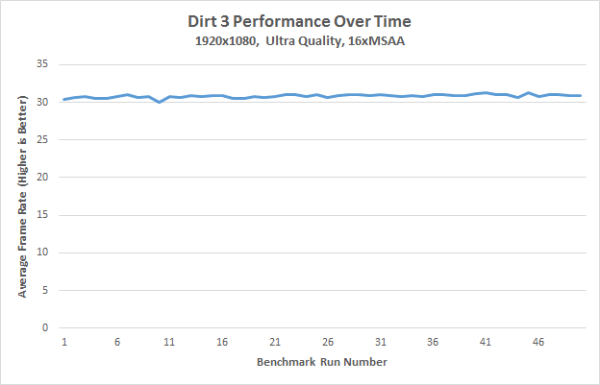The New Razer Blade: Thoroughly Reviewed
by Vivek Gowri on October 3, 2012 5:40 PM ESTRazer Blade (late 2012) - Thermal Design
Razer took a system that was already near the brink of its thermal envelope, tossed about 50% more compute power into it, added 12 watts to the power draw, and tried to still keep it within reasonable operating temperatures. So now we get to see if Razer’s engineering team managed to pull it off.
A quick refresher from last time: the Blade was hot. Damn hot. We saw internal temperatures of 95C on the CPU and 80C on the GPU under loaded conditions, numbers that we were simply not that comfortable with. But it wasn’t just at load; this was a system that got relatively toasty even at idle, where we saw temperatures in the 50-60C range. This resulted in a system that ran hot to the touch (though most of this heat was directed away from areas that are commonly touched like the keyboard and palmrests) and constantly had the fan running, even when bouncing around the internet or YouTube. Put simply: not great.
Thankfully, the redesigned cooling system has helped tremendously, particularly at low load. The system now idles in the 37-42C range, significantly lower than the 55ish it used to go for, and it’s very rare to see the fans spool up until you start gaming. I put it through my typical 100% system load, basically using Furmark 1080p and wPrime 1024M looping to peg both CPU and GPU load at 100% for a sustained period of time to see where temperatures settled. wPrime is multithreaded so with 8 threads it's loading all four cores equally. I saw CPU temperature settle in the 85C range, while GPU temperature maxed out at 90C. It’s still pretty hot, but even at a sustained hour-long clip, I never saw throttling—the GPU core was pegged at 950MHz—and the fan itself was much less intrusive than before.
To put this to the test in a real-world gaming situation, I fired up our DiRT 3 benchmark (it’s built into the game) and ran it fifty times in a row. I tested at our Enthusiast setting, which is 1080p, Ultra High quality, and 4xMSAA, and each run, including cut-scenes, totalled about 2 minutes and 20 seconds, give or take ten seconds—it’s not the exact same clip each time, as AI is typically different, which impacts the race results and elapsed times. That’s essentially two hours of gaming, with a fairly new game running at maximum settings. My performance over time graph ended up being as flat as Wyoming—almost no deviation in performance, beyond random test-to-test variation. I ran a similar test on the MacBook Pro (except with Anand’s OS X Half-Life 2 benchmark) and by run 30, the downward trend was pretty clear. I ran that 40 times, but I went even longer here to see if I could establish any kind of pattern. All I got was a really consistent 30.75fps, give or take one. I was impressed, to say the least.
A quick note—I was unequipped to test fan noise, but I can say that even under full load, the new fans are much quieter than the old fans were even under part loading. The new fans seem to be running at a lower RPM as well, which was no doubt helped by the larger venting; it’s a really big improvement from before.












59 Comments
View All Comments
davos555 - Thursday, October 4, 2012 - link
As one of the 10% of left handed people, I couldn't use this. I much prefer the trackpad in the middle, as I draw with my left hand (use my finger) and click with the right hand. I couldn't use it comfortably where it is on this.Old_Fogie_Late_Bloomer - Thursday, October 4, 2012 - link
And I'm a righty, but I tend to mouse lefty when I'm not gaming to even the wear and tear on my wrists. Heck, at work I use my left hand almost exclusively. That trackpad just isn't a viable solution for me. :-\adityav - Thursday, October 4, 2012 - link
Its a problem for left handers like me. I am willing to buy this but that trackpad position won't work for me.tipoo - Wednesday, October 3, 2012 - link
As we all know, that was the first and only black laptop before this.Kidding, but I don't see much similarity beside that, I don't have to repeat that the chicklet keyboard isn't unique to the MB either.
tbutler - Thursday, October 4, 2012 - link
The 'form over function' slam is really irritating. This is a *laptop.* The entire point is being able to tote it around. (If desktop space is limited, an AIO or SFF will still give you more bang for the buck than a laptop if you're not going to be carrying it around.)Therefore, size and weight are FUNCTIONAL issues. Not fashion. Size/weight vs performance is still a valid discussion, but it's a choice between two different kinds of functionality - not form over function.
By the same token, case materials are a functional issue. Logo stickers, sculpted flanges, all that crap is form - but a solid metal build vs the kind of cheap plastic described in yesterday's Clevo review will definitely affect the laptop's operation. Again, goes back to portability; a well-built case is going to hold up better under the wear and tear portable systems experience, and do a better job of protecting the internal components.
Octopilion - Friday, October 5, 2012 - link
Your argument is pointless mac book pros don't even have these specs and cost about the same price and there's a ton of sheep buying themCaptainDoug - Wednesday, October 3, 2012 - link
I just wish that there was some way to just install the OS on the Msata and then have my hard drive for anything else. I really don't get caching. I get it, but it's lame. For me, this second revision makes it a much more serious contender but I think I'd still choose the HP ENVY 17t-3200 series. You get a msata port + 2x2.5" drives. The 7850M is only slightly worse than the 660M and it has amazing sound. True it is 1.28" thick instead of .88" but it's also $1000 less and comes with a blu-ray drive. I totally understand why someone would want this though. I'm not bashing on this laptop at all, it's just not everything i want. If the Razer Blade R2 was somehow user upgradeable/configurable, that's another story. 16GB of ram, and replacable hard drives isn't too much to ask is it? That being said, if I had money to blow, I'd get this for the coolness factor over the HP Envy.JarredWalton - Wednesday, October 3, 2012 - link
I wish Razer would offer a build with a 256GB mSATA SSD with the OS and apps, and then provide a 750GB/1TB HDD for mass storage. (Or just leave the 2.5" bay open and let users add something on their own if they need more storage.) I'd also be far happier with a traditional touchpad and save the money that it costs to put the Switchblade into the laptop.VivekGowri - Wednesday, October 3, 2012 - link
If you're willing to get intimate with the DataPlex software, you can theoretically uninstall it and set up the mSATA SSD as the boot/application drive. I'm not sure why Razer didn't go that route with it, I guess it was just cheaper for them to give a smaller caching drive?s2kpacifist - Wednesday, October 3, 2012 - link
This looks like a great second entry into the gaming laptop market, but I really wish if they had a 15" flavor of the Blade, sans Switchblade. Hell, maybe even a 17" version without the switchblade touchpad. The reason? Any serious gamer will undoubtedly be using high dpi mouse for the game they are playing. The whole concept of the Switchblade is innovative, but it's probably adding some unnecessary cost and features most gamers can do without. The buttons are okay, but until Razer can get the trackpad screen to out-do what most modern smartphones can do in terms of responsiveness, browsing experience, and dpi/resolution, I think Razer can do much better without Switchblade .